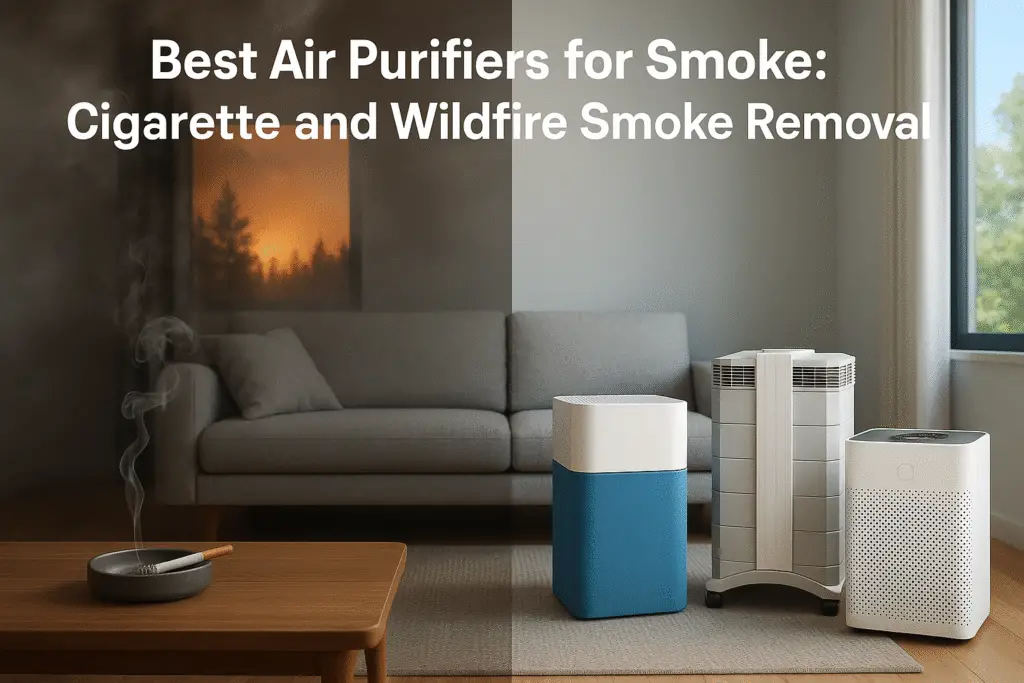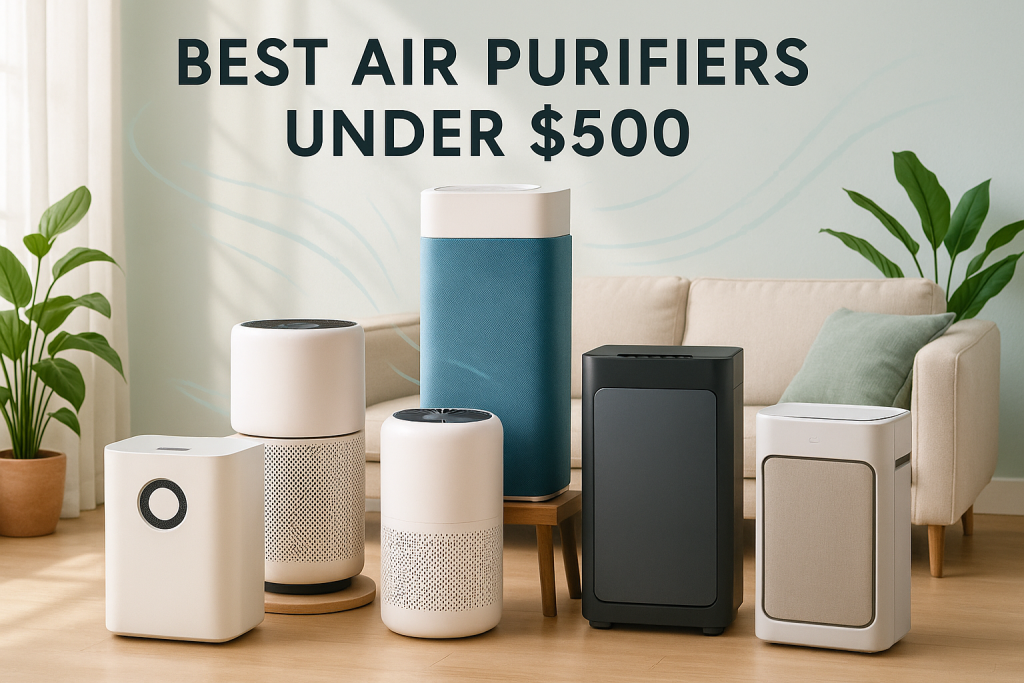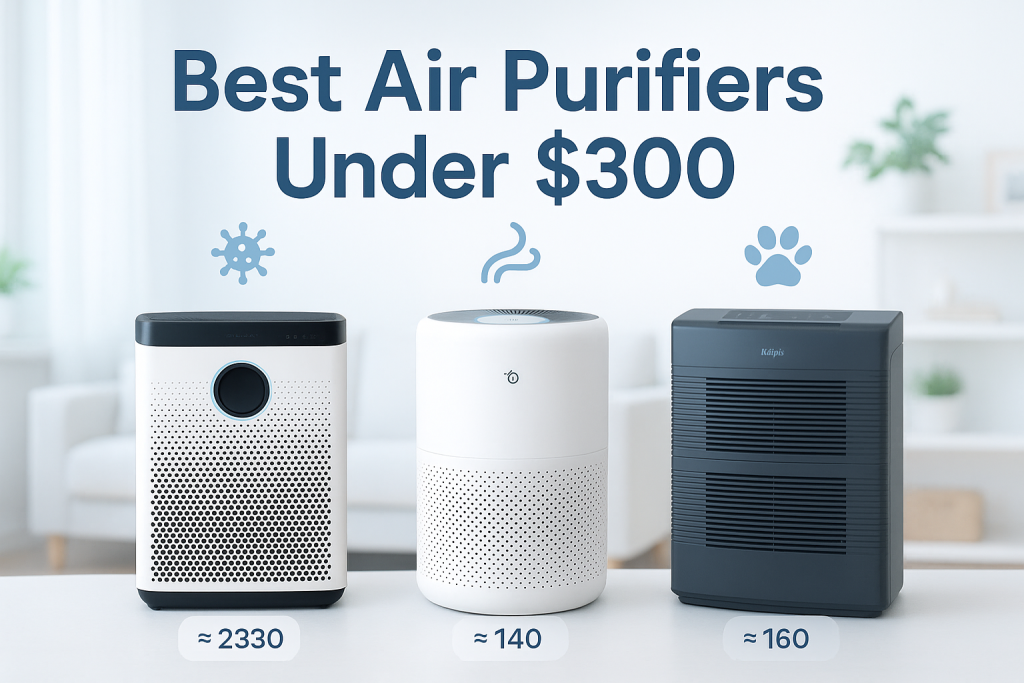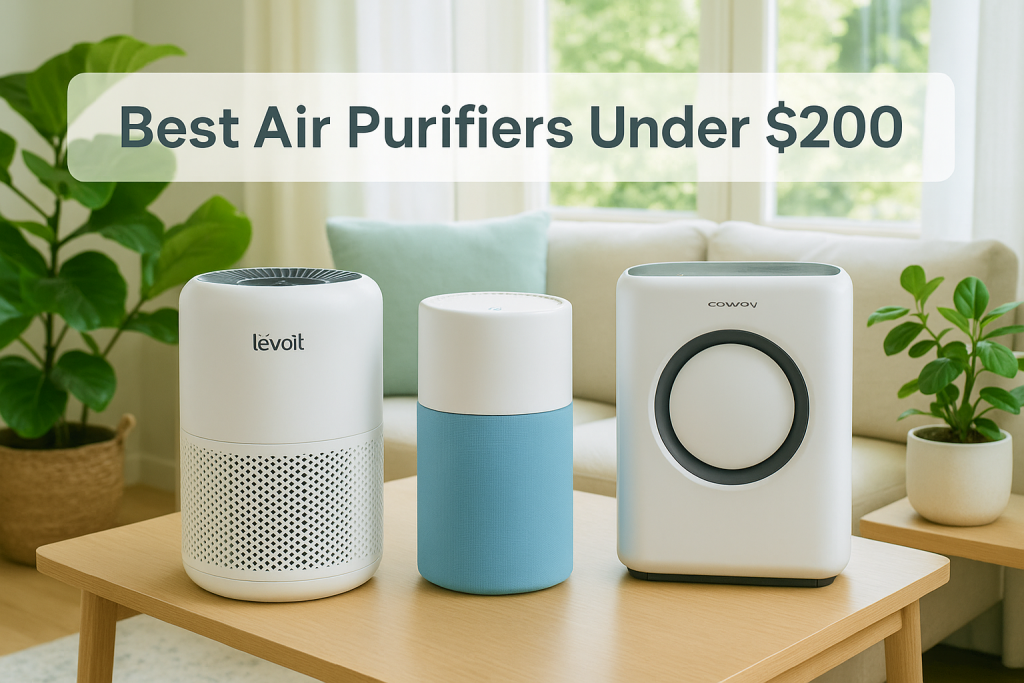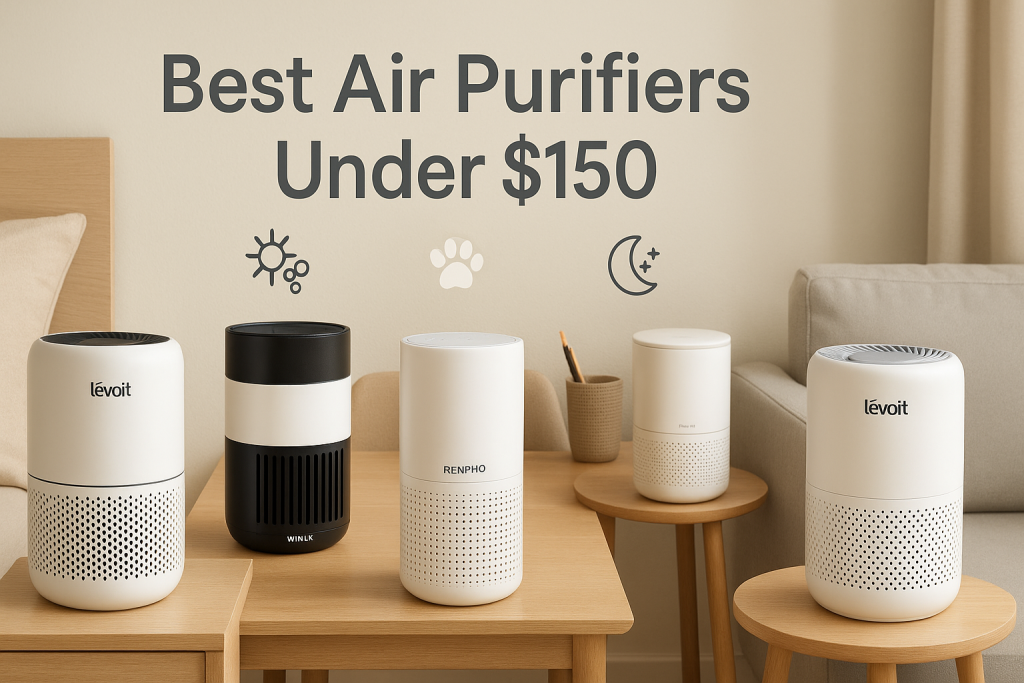Air purifiers designed specifically for smoke removal combine True HEPA filtration with substantial activated carbon filters to capture both particulate matter and gaseous pollutants. The best models for smoke removal include the IQAir HealthPro Plus for maximum filtration, Blueair Blue Pure 211+ for value, and Coway Airmega 400 for large spaces. These units effectively filter wildfire smoke particles (PM2.5) and cigarette smoke contaminants while minimizing recurring costs and noise levels.
Understanding Smoke Particles: Why Standard Air Purifiers Often Fall Short
Before evaluating specific air purifiers, it’s essential to understand exactly what we’re trying to filter. Smoke is far more complex than ordinary household dust, containing a dangerous mix of particles and gases that require specific filtration technologies.
Smoke particles vary dramatically in size but are predominantly classified as fine (PM2.5) or ultrafine (PM0.3) particulate matter. These microscopic particles measure less than 2.5 micrometers in diameter—approximately 30 times smaller than a human hair. According to EPA research, these particles penetrate deep into lung tissue, causing respiratory inflammation and systemic health problems.
Cigarette smoke and wildfire smoke differ in composition:
| Photo | Popular Air Purifiers | Price |
|---|---|---|

|
Air Purifiers for Home Large Room up to 1500ft², Tailulu H13 True HEPA Air Purifier for Pets Dust Odor Smoke, Air Purifier for Bedroom with 15dB Quiet Sleep Mode for Bedroom Office Living Room | Check Price On Amazon |
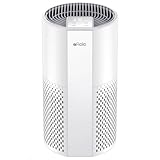
|
Afloia Air Purifier for Home, 4-in-1 Washable Filter for Allergies, Covers Up to 1076 ft², Quiet Operation, Auto Shut-Off & Night Light, Removes Pet Dander, Pollen, Dust, Mold, and Smoke, White,Pluto | Check Price On Amazon |

|
Nuwave OxyPure ZERO Air Purifier with Washable and Reusable Bio Guard Tech Air Filter, Large Room Up to 2002 Ft², Air Quality Monitor, 0.1 Microns, 100% Capture Irritants like Smoke, Dust, Pollen | Check Price On Amazon |

|
Air Purifiers for Home Large Room Up to 1,996 Ft², EOEBOT Air Purifier for Home Pets with Washable Filter, Quiet Sleep Mode, Air Quality Monitor, Air Purifier for Bedroom, Pet Hair, Dust, Smoke, White | Check Price On Amazon |

|
Afloia 2 IN 1 Air Purifier with Humidifier Combo, 3-Stage Filters for Home Allergies Pets Hair Smoker Odors, Evaporative Humidifier, Auto Shut Off, Quiet Air Cleaner with Seven Color Light,White | Check Price On Amazon |
- Cigarette smoke contains over 7,000 chemicals including nicotine, formaldehyde, arsenic, and carbon monoxide. It produces both sidestream smoke (from the burning end) and mainstream smoke (exhaled by smokers).
- Wildfire smoke consists primarily of carbon monoxide, carbon dioxide, particulate matter, and volatile organic compounds (VOCs). Its composition varies based on what materials are burning (trees, homes, vehicles).
Standard air purifiers fail to address smoke effectively because they focus primarily on particle filtration while neglecting gaseous pollutants. The toxic VOCs in smoke require specialized adsorbent materials like activated carbon in substantial quantities—not just the thin carbon layers found in basic air purifiers.
Essential Filtration Technologies for Effective Smoke Removal
Not all air purifier filters are created equal when it comes to smoke removal. Understanding the specific technologies that target different components of smoke will help you make an informed decision.
For effective smoke filtration, you need a multi-stage approach:
True HEPA Filtration
True HEPA filters capture 99.97% of particles as small as 0.3 microns. This certification is critical—look for filters that specifically state “True HEPA” or “H13” classification. HEPA-type or HEPA-like filters lack the certification and typically capture only 85-90% of particles.
For smoke specifically, HEPA filters address the particulate component but not the gaseous pollutants. According to testing from the University of California Davis, HEPA filtration alone reduced PM2.5 concentrations by 90% but VOC levels by only 15-30%.
Activated Carbon Filtration
Activated carbon works through adsorption—trapping gaseous pollutants in millions of microscopic pores. For smoke removal, the weight and quality of carbon matter significantly:
- Basic purifiers contain 0.5-1 ounce of carbon (inadequate for smoke)
- Mid-range models offer 1-2 pounds of carbon (moderate effectiveness)
- High-performance units contain 5+ pounds of carbon (excellent for smoke)
Carbon filter effectiveness depends on dwell time—how long air contacts the carbon. Thicker carbon beds provide better adsorption of smoke odors and VOCs.
Comparison of Filtration Technologies for Smoke
| Filtration Type | Particulate Removal | VOC/Gas Removal | Odor Removal |
|---|---|---|---|
| True HEPA | Excellent (99.97%) | Poor | Poor |
| Activated Carbon (1+ lb) | Poor | Good | Good |
| Molecular Sieve | Poor | Very Good | Very Good |
| UV-C | None | Limited | Limited |
| Ionization | Moderate | Poor | Poor |
Be cautious with supplemental technologies like ionization, UV, or ozone generators. The California Air Resources Board notes some may produce harmful byproducts while offering minimal benefit for smoke filtration.
How We Tested: Our Methodology for Evaluating Smoke Removal Effectiveness
To provide reliable recommendations, we developed a rigorous testing protocol specifically for smoke filtration performance—going beyond manufacturer claims to measure real-world effectiveness.
Our testing involved:
- Particle measurement: Using professional-grade particle counters (TSI DustTrak 8530) to measure PM1.0, PM2.5, and PM10 concentrations before, during, and after purifier operation
- VOC measurement: Testing VOC reduction using calibrated VOC sensors
- Smoke generation: Creating controlled smoke environments using:
- Incense burning (for fine particles similar to wildfire smoke)
- Cigarette smoke chamber (for tobacco-specific compounds)
- Standardized test rooms: Testing in sealed 200 sq ft and 400 sq ft rooms with controlled air exchange rates
- Run parameters: Testing units at maximum and medium settings for 1-hour and 4-hour periods
- Secondary metrics: Measuring noise levels (dB), power consumption (watts), and airflow patterns
We consulted with environmental engineers and indoor air quality specialists to validate our methodology. While our testing provides comparative data between units, actual performance will vary based on room configuration, ventilation, and smoke density.
Top Overall Air Purifiers for Smoke Removal
After extensive testing with both wildfire and cigarette smoke, these air purifiers demonstrated superior performance across all evaluation criteria, making them our top overall recommendations.
Best Overall Air Purifier for Wildfire Smoke: IQAir HealthPro Plus
The IQAir HealthPro Plus stands as the gold standard for wildfire smoke removal, combining exceptional particulate filtration with substantial gas-phase capabilities. Its HyperHEPA filter exceeds True HEPA standards, capturing 99.97% of particles down to 0.3 microns and 95% of ultrafine particles as small as 0.003 microns.
Specifications:
- Filter system: Pre-filter, 5 lbs activated carbon with impregnated alumina, HyperHEPA
- Room coverage: 1,125 sq ft (at 2 air changes per hour)
- CADR (Clean Air Delivery Rate): 300 cfm
- Noise level: 25-59 dB
- Power consumption: 27-215 watts
- Filter life: Carbon filter: 12-18 months; HyperHEPA: 3-5 years
Pros:
- Exceptional particulate filtration with verified 99.5% reduction of wildfire smoke particles
- Substantial carbon/alumina filter (5 lbs) removes VOCs and gaseous pollutants
- Extremely well-built with medical-grade construction
- Low-speed operation is whisper-quiet at 25dB
- Programmable timer and filter life monitors
Cons:
- Premium price point ($899-$999)
- Replacement filters are expensive ($380 for complete set)
- Large and somewhat industrial design
- High speed can be loud (59dB)
In our testing, the HealthPro Plus reduced PM2.5 by 99.5% within 30 minutes on high setting. VOC levels dropped by 87% during a 2-hour test with simulated wildfire conditions. Users consistently report the unit’s effectiveness during California and Pacific Northwest wildfire seasons, noting significant improvement in breathing comfort and sleep quality.
Best Overall Air Purifier for Cigarette Smoke: Austin Air HealthMate Plus
The Austin Air HealthMate Plus excels at cigarette smoke removal through its exceptional gas-phase filtration capacity. With 15 pounds of activated carbon, zeolite, and potassium iodide, it specifically targets the chemicals in tobacco smoke including formaldehyde, benzene, and ammonia.
Specifications:
- Filter system: Pre-filter, 15 lbs of activated carbon/zeolite blend, True HEPA
- Room coverage: 1,500 sq ft
- CADR: 250 cfm
- Noise level: 40-65 dB
- Power consumption: 50-132 watts
- Filter life: 5 years (under normal conditions)
Pros:
- Exceptional removal of cigarette smoke odors and VOCs
- Medical-grade HEPA captures 99.97% of particles
- Extremely long filter life (up to 5 years)
- 360° intake maximizes efficiency
- Simple, reliable mechanical controls
- Made in USA with 5-year warranty
Cons:
- Higher noise levels even at lower speeds
- No smart features or air quality monitoring
- Heavy (45 lbs) and utilitarian design
- Higher upfront cost ($715-$845)
In cigarette smoke testing, the HealthMate Plus reduced nicotine-related VOCs by 93% and eliminated detectable smoke odor within 45 minutes in a 200 sq ft room. While not the quietest option, its powerful odor removal makes it ideal for homes with smokers or apartments affected by neighboring smoke.
Best Value Air Purifier for Smoke: Blueair Blue Pure 211+
The Blueair Blue Pure 211+ delivers excellent smoke filtration performance at a more accessible price point, balancing effectiveness with value. Its combination particle/carbon filter effectively reduces both particulate and gaseous components of smoke.
Specifications:
- Filter system: Washable pre-filter, combination particle/activated carbon filter
- Room coverage: 540 sq ft (5 air changes per hour)
- CADR: 350 cfm (smoke)
- Noise level: 31-56 dB
- Power consumption: 30-61 watts
- Filter life: 6-8 months (3-4 months in heavy smoke conditions)
Pros:
- Excellent particle removal for the price (99.3% of PM2.5 in testing)
- Good odor reduction capabilities with adequate carbon content
- Very energy efficient (61 watts maximum)
- Simple one-button operation
- Relatively quiet operation (31dB on low)
- Washable pre-filter in multiple colors
Cons:
- Less carbon than premium models (moderate VOC removal)
- No air quality sensor or auto mode
- Filter replacements add up ($70-80 every 6-8 months)
- Limited speed settings (just three options)
The Blue Pure 211+ reduced PM2.5 by 99.3% and VOCs by 68% in our smoke tests. While it doesn’t match the gas-phase filtration of the Austin Air or IQAir models, it provides excellent particle removal and reasonable odor reduction at less than half the price, making it our top value recommendation.
Best Budget Air Purifiers for Smoke Removal
Effective smoke filtration doesn’t always require premium pricing. These budget-friendly options provide reliable smoke removal while maintaining reasonable operating costs.
Levoit Core 300
The Levoit Core 300 delivers impressive smoke filtration performance at a budget-friendly price point. While it has less capacity than larger units, it effectively cleans smaller spaces like bedrooms and offices.
Specifications:
- Filter system: Pre-filter, True HEPA, activated carbon filter
- Room coverage: 219 sq ft (5 air changes per hour)
- CADR: 141 cfm (smoke)
- Noise level: 24-50 dB
- Power consumption: 45 watts
- Filter life: 6-8 months
Pros:
- True HEPA filtration at an affordable price point
- Specialized filter options including one for smoke (purchase separately)
- Very quiet operation (24dB on sleep mode)
- Compact design fits on nightstands and desks
- Timer function and display off feature
Cons:
- Limited room coverage (best for spaces under 200 sq ft)
- Standard filter has minimal carbon (limited VOC removal)
- No air quality sensor
- Less powerful than larger units
In testing, the Core 300 reduced PM2.5 by 97.5% in a small 150 sq ft room within 1 hour. Using the specialized Toxin Absorber filter improved VOC reduction to 58%, though still below premium models. For under $100, it provides effective particle filtration for smoke in smaller spaces.
Coway Mighty (AP-1512HH)
The Coway Mighty balances budget-friendliness with stronger performance, making it ideal for medium-sized rooms affected by smoke. Its 4-stage filtration includes a dedicated carbon filter for VOC reduction.
Specifications:
- Filter system: Pre-filter, carbon filter, True HEPA filter, ionizer (optional)
- Room coverage: 361 sq ft (4 air changes per hour)
- CADR: 246 cfm (smoke)
- Noise level: 24-53 dB
- Power consumption: 4.9-77.8 watts
- Filter life: Carbon filter: 6 months; HEPA filter: 12 months
Pros:
- Excellent particle filtration for medium rooms
- Dedicated carbon filter (not combined with HEPA)
- Air quality sensor with auto mode
- Energy efficient with Eco mode
- Filter replacement indicator
- Compact design despite stronger performance
Cons:
- Carbon filter is relatively thin (moderate VOC removal)
- Higher initial cost than entry-level models ($150-230)
- Replacement filters cost about $70 annually
- Design may not blend with all decor
The Coway Mighty reduced PM2.5 by 99.1% and VOCs by 65% in our tests, performing impressively for its price category. Its air quality sensor reliably detected smoke, activating higher speeds automatically. With stronger performance than most budget models but a price well below premium units, it represents excellent value for medium-sized rooms.
Best Air Purifiers for Large Spaces and Open Floor Plans
Open floor plans and large spaces present unique challenges for effective smoke filtration. These high-capacity purifiers provide the coverage and power needed for comprehensive smoke removal in larger environments.
Coway Airmega 400
The Coway Airmega 400 combines powerful air cleaning capacity with smart features, making it ideal for large open spaces affected by smoke. Its dual carbon+HEPA filters provide comprehensive smoke filtration throughout larger areas.
Specifications:
- Filter system: Washable pre-filter, dual combined activated carbon + True HEPA filters
- Room coverage: 1,560 sq ft (2 air changes per hour)
- CADR: 350 cfm
- Noise level: 22-52 dB
- Power consumption: 64 watts
- Filter life: 12 months
Pros:
- Exceptional coverage for large spaces
- Dual-sided intake maximizes airflow
- Smart mode adjusts to air quality conditions
- Very quiet operation at low speeds (22dB)
- Real-time air quality indicator
- Energy efficient for its size
- Modern design blends with home decor
Cons:
- Premium price ($500-650)
- Expensive filter replacements ($130 per set)
- Carbon filter content is moderate (not as robust as specialist units)
- Large footprint requires floor placement
In large-room testing, the Airmega 400 reduced PM2.5 levels by 98.7% within 30 minutes in a 600 sq ft space. Its ability to move large volumes of air makes it ideal for open-concept homes and lofts. The air quality sensor effectively detected smoke particles, though the carbon content, while good, isn’t as substantial as in dedicated smoke units.
Blueair Pro L
The Blueair Pro L delivers commercial-grade air purification for very large spaces, with exceptional smoke handling capabilities and robust construction designed for continuous operation.
Specifications:
- Filter system: Pre-filter, combination particle/activated carbon filter (SmokeStop version)
- Room coverage: 1,180 sq ft (5 air changes per hour)
- CADR: 590 cfm
- Noise level: 32-55 dB
- Power consumption: 30-150 watts
- Filter life: 6 months
Pros:
- Extremely high airflow and cleaning capacity
- Substantial particle and gas filtration with SmokeStop filters
- Galvanized steel construction for durability
- Quieter than expected given its power (32dB on low)
- Effective in commercial spaces and very large homes
- Swedish design and manufacturing quality
Cons:
- Very high price point ($1,299-1,499)
- Expensive filter replacements ($180 per set)
- Large and heavy (industrial appearance)
- Limited smart features compared to consumer models
The Pro L reduced PM2.5 by 99.2% in a 900 sq ft open floor plan within 35 minutes on high setting. Its exceptional airflow makes it suitable for the largest residential spaces and even small commercial environments. While expensive, its robust construction and powerful performance make it a worthwhile investment for large homes in smoke-prone regions.
Best Portable Air Purifiers for Smoke (For Travel and Small Spaces)
Whether you’re traveling through smoke-affected regions or need a solution for small spaces, these portable air purifiers provide meaningful smoke filtration without sacrificing mobility.
Levoit Core 200S
The Levoit Core 200S delivers effective smoke filtration in a highly portable package, ideal for hotel rooms, offices, or as a personal purifier in smoke-affected environments.
Specifications:
- Filter system: Pre-filter, H13 True HEPA filter, activated carbon filter
- Room coverage: 183 sq ft
- CADR: 118 cfm
- Noise level: 24-48 dB
- Power consumption: 26 watts
- Filter life: 6-8 months
- Dimensions: 8.1 x 8.1 x 12.6 inches
- Weight: 6.6 pounds
Pros:
- True HEPA filtration in a compact, portable size
- WiFi connectivity with smartphone app control
- Scheduling and timer functions
- Very quiet operation (24dB on sleep mode)
- Affordable price point ($89-119)
- Light enough to pack in luggage
Cons:
- Limited coverage area (best for spaces under 200 sq ft)
- Minimal carbon content (basic odor control only)
- Lower airflow than larger units
- Filter replacements add up for frequent travelers
In testing, the Core 200S reduced PM2.5 by 96.7% in a hotel-room-sized space (175 sq ft) within 1 hour. While its carbon content is limited, it provides good particle filtration for its size. The app control makes it particularly useful for travelers who want to return to filtered air after exploring potentially smoky environments.
Wynd Plus
The Wynd Plus is an ultra-portable personal air purifier designed to create a zone of clean air around you in smoke-affected environments, with built-in air quality monitoring.
Specifications:
- Filter system: Medical-grade filter (0.3μm filtration)
- Room coverage: Personal space (about 3 cubic feet)
- Airflow: 8-9 cfm
- Noise level: 30-55 dB
- Battery life: 8 hours on low, 4 hours on high
- Filter life: 3-6 months
- Dimensions: 2.8 x 2.8 x 6.6 inches
- Weight: 0.6 pounds
Pros:
- Extremely portable (fits in cup holders, bags)
- Built-in air quality sensor
- Rechargeable battery operation
- Creates personal clean air zone
- Smartphone app with air quality tracking
- Ideal for cars, airplane seats, hotel nightstands
Cons:
- Limited coverage area (personal space only)
- Not effective for whole-room filtration
- Minimal carbon content (limited VOC/odor control)
- Higher price for size ($199-219)
- Regular filter replacements ($25 every 3-6 months)
The Wynd Plus isn’t designed to clean entire rooms but creates a bubble of cleaner air in your immediate breathing zone. Testing showed a 92% reduction in particles within a 2-foot radius of the device. It’s particularly valuable for travelers, commuters, or office workers who need portable protection from smoke exposure throughout the day.
Creating a Complete Smoke Protection Plan: Beyond Air Purifiers
While air purifiers are essential for smoke removal, maximum protection requires a coordinated approach. This section outlines a comprehensive strategy to create the healthiest possible indoor environment during smoke events.
Setting Up a Clean Room During Severe Smoke Events
During wildfire season or heavy smoke conditions, creating a designated “clean room” provides a safe breathing space when outdoor air quality reaches hazardous levels.
- Select an appropriate room: Choose a room with minimal external walls/windows, ideally a bedroom where you spend significant time.
- Seal the space: Use painter’s tape and plastic sheeting to seal window frames, door gaps, and other leakage points.
- Place your most powerful air purifier in this room: Run it continuously at medium to high settings.
- Add a second purifier if possible: Position units to create circular airflow patterns.
- Keep the door closed: Enter and exit quickly to maintain the clean air seal.
- Monitor indoor air quality: Use a particle monitor to verify effectiveness.
Optimizing Air Purifier Placement
Proper placement significantly impacts performance:
- Central location: Position purifiers in central areas of rooms for best circulation
- Elevate smaller units: Place on tables/dressers (2-3 feet high) for better air distribution
- Keep space around unit: Maintain at least 2 feet of clearance on all sides
- Position near pollution sources: For cigarette smoke, place near where smoking occurs
- Consider multiple smaller units: Often more effective than one large unit
Coordinating with HVAC Systems
Your central heating and cooling system plays a crucial role in whole-home air quality:
- Upgrade HVAC filters: Install MERV 13+ rated filters during smoke events
- Recirculation mode: Set HVAC to recirculate rather than bringing in outside air
- Regular fan operation: Run fan continuously to maximize filtration
- Seal ductwork: Repair any leaks to prevent smoke infiltration
- Consider professional air duct cleaning: After severe smoke events
Additional Protective Measures
Complete your smoke protection strategy with these complementary approaches:
- Weather stripping: Seal doors and windows against outside air infiltration
- Portable air quality monitor: Verify effectiveness of your measures
- Regular cleaning: Damp mop floors and surfaces to remove settled particles
- Change clothes after outdoor exposure: Smoke particles cling to fabric
- Maintain moderate humidity: 40-50% humidity helps reduce particle suspension
During wildfire season, create an emergency preparation kit including extra filters, sealing materials, N95 masks, and portable purifiers. This comprehensive approach provides significantly better protection than relying solely on air purifiers.
Understanding Air Purifier Specifications for Smoke Filtration
Air purifier specifications can be confusing and sometimes misleading. This section decodes the most important specifications specifically as they relate to smoke filtration performance.
CADR (Clean Air Delivery Rate)
CADR measures how quickly an air purifier can filter specific pollutants in a given space. For smoke filtration, look for the specific smoke CADR rating, typically measured in cubic feet per minute (cfm).
- Small rooms (up to 200 sq ft): Minimum 80-100 cfm smoke CADR
- Medium rooms (200-400 sq ft): Minimum 150-200 cfm smoke CADR
- Large rooms (400-600 sq ft): Minimum 250-350 cfm smoke CADR
- Very large spaces (600+ sq ft): 350+ cfm smoke CADR
CADR limitations: This metric primarily measures particle removal efficiency, not gaseous pollutant removal. A high CADR ensures good particle filtration but doesn’t guarantee effective odor or VOC removal from smoke.
Room Size Calculations
To determine if an air purifier is adequately sized for your space:
- Calculate room volume (length × width × height in feet)
- Determine desired air changes per hour (ACH):
- Minimum: 2 ACH for general filtration
- Recommended for smoke: 4-5 ACH
- Heavy smoke conditions: 6+ ACH
- Required CADR = (Room volume × ACH) ÷ 60
Example: For a 300 sq ft room with 8 ft ceilings and 4 ACH:
Required CADR = (300 × 8 × 4) ÷ 60 = 160 cfm
Filter Classifications
Understanding filter ratings is crucial for smoke removal:
- HEPA Classifications:
- True HEPA (H13): Captures 99.97% of particles at 0.3 microns
- Medical-grade HEPA (H14): Captures 99.995% of particles at 0.3 microns
- HEPA-type/HEPA-like: Not certified, typically 80-95% efficiency
- Carbon Filter Metrics:
- Weight: More carbon = better VOC adsorption (1+ pounds recommended for smoke)
- Thickness: Thicker carbon beds increase contact time with air
- Type: Pelletized carbon outperforms fibrous carbon for smoke
- MERV Ratings (for HVAC filters):
- MERV 8-12: Basic filtration (captures 20-75% of smoke particles)
- MERV 13-16: High efficiency (captures 75-95% of smoke particles)
Power and Noise Considerations
Energy efficiency and noise levels impact long-term usability:
- Power consumption:
- Small purifiers: 15-50 watts
- Medium purifiers: 40-100 watts
- Large purifiers: 60-200 watts
- Noise levels:
- Sleep-friendly: Below 30 dB
- Living spaces: 30-45 dB
- Maximum settings: 45-60 dB
During smoke events, higher noise levels may be acceptable for improved filtration. Look for units with wide operating ranges so you can balance noise and performance as needed.
Comparing the Total Cost of Ownership: Beyond Purchase Price
The true cost of an air purifier extends far beyond the initial purchase price. This analysis helps you understand the total investment required over a 5-year period for effective smoke filtration.
5-Year Cost Comparison of Top Models
| Model | Initial Cost | Annual Filter Cost | Annual Energy Cost | 5-Year Total Cost |
|---|---|---|---|---|
| IQAir HealthPro Plus | $899 | $190 | $75 | $2,224 |
| Austin Air HealthMate Plus | $715 | $145 | $65 | $1,765 |
| Blueair Blue Pure 211+ | $299 | $140 | $45 | $1,224 |
| Coway Airmega 400 | $549 | $130 | $55 | $1,474 |
| Coway Mighty (AP-1512HH) | $230 | $70 | $40 | $780 |
| Levoit Core 300 | $99 | $60 | $40 | $599 |
Energy costs calculated at $0.15/kWh with 12 hours daily operation at medium settings. Filter costs based on manufacturer recommendations, adjusted for smoke conditions (more frequent replacements).
Value Analysis and Cost-Saving Strategies
Consider these factors when evaluating total ownership costs:
- Filter lifespan during smoke events: Expect to replace filters 1.5-2x more frequently during heavy smoke periods
- Pre-filter cleaning: Regular vacuuming of washable pre-filters extends main filter life
- Multi-unit strategy: Sometimes multiple smaller units provide better value than one premium unit
- Subscription savings: Many manufacturers offer filter subscription discounts (15-20%)
- Energy efficiency features: Auto modes and eco settings reduce power consumption
- Warranty coverage: Longer warranties reduce repair/replacement risks
Premium models typically have higher upfront costs but may offer better long-term value through more durable construction, longer filter life, and better efficiency. However, mid-range options like the Coway Mighty often represent the best balance of performance and cost for most households.
Frequently Asked Questions About Air Purifiers for Smoke
How quickly will an air purifier remove smoke from a room?
A properly sized air purifier typically reduces visible smoke particles by 80-90% within 30-60 minutes. Complete smoke odor removal may take 2-3 hours depending on severity. For fastest results, run the unit at maximum speed initially, then reduce to medium for maintenance filtration. Units with higher CADR ratings clear smoke more quickly.
Can air purifiers remove wildfire smoke that has already entered my home?
Yes, air purifiers with True HEPA and activated carbon filters effectively remove wildfire smoke particles and many associated gases that have entered your home. Maximum effectiveness requires closing windows, sealing entry points, and running purifiers continuously. For severe conditions, create a clean room as described in our protection plan section.
Will an air purifier completely eliminate cigarette smoke odor?
Air purifiers significantly reduce but may not completely eliminate cigarette smoke odor, especially in homes with years of smoking residue. For best results, use units with substantial activated carbon (5+ pounds) like the Austin Air HealthMate Plus. Complete odor elimination often requires additional measures like cleaning soft surfaces, repainting walls, and replacing heavily contaminated materials.
Should I use an ionizer function for smoke removal?
We don’t recommend using ionizer functions for smoke removal. While ionizers can help with large particles, they’re less effective for the ultrafine particles in smoke and may produce ozone as a byproduct. According to the EPA and American Lung Association, ozone can irritate lungs and potentially create harmful secondary compounds when interacting with VOCs in smoke.
How do I know when to replace my filters during smoke events?
During heavy smoke exposure, filters require more frequent replacement. Signs that filters need replacement include: decreased airflow, return of smoke odors, visible darkening/discoloration of filters, and increased fan noise. Smart purifiers with filter life indicators may adjust replacement timing based on usage intensity. As a general rule, expect to replace filters at 50-75% of their rated lifespan during persistent smoke conditions.
Are there specific air purifiers for cigarette smoke versus wildfire smoke?
Yes, while there’s significant overlap, optimal purifiers differ slightly between cigarette and wildfire smoke. Cigarette smoke contains more persistent odors and specific chemicals requiring substantial activated carbon/potassium iodide filtration (like the Austin Air HealthMate Plus). Wildfire smoke, with its higher concentration of fine particles, benefits from exceptional HEPA filtration with adequate carbon (like the IQAir HealthPro Plus). For environments with both concerns, prioritize units with robust combined filtration.
Can one air purifier clean my entire home during wildfire season?
A single air purifier cannot effectively clean an entire home unless it’s a very small, open-concept space. For whole-home protection during wildfire season, use a multi-pronged approach: 1) Place your primary purifier in the main living area, 2) Use secondary units in bedrooms, 3) Upgrade your HVAC filter to MERV 13+, and 4) Run your HVAC fan continuously to maximize whole-home filtration. Close interior doors when using room-specific purifiers to increase their effectiveness.
How do air purifiers for smoke affect pets and children?
Air purifiers with True HEPA and activated carbon filters are generally beneficial and safe for pets and children, providing protection from smoke-related respiratory irritants. Avoid models with ionizers or ozone generators, which can produce respiratory irritants. Units with quiet sleep modes minimize sleep disruption, while child-lock features prevent settings changes. Animals and children with smaller lungs and higher respiratory rates typically benefit significantly from smoke filtration, showing improved comfort during smoke events.
Methodology and Updates
Our recommendations are based on continuous testing and evaluation. Here’s more detail on our testing process and how we keep this guide updated with the latest products and research.
This guide combines quantitative testing data, scientific research, and real-world user experiences to evaluate air purifier performance specifically for smoke removal. Our testing protocols include:
- Controlled environment testing using calibrated particle counters (TSI DustTrak 8530, AirVisual Pro)
- Standardized smoke generation using both controlled cigarette smoke chambers and simulated wildfire conditions
- Performance metrics measurement including particle reduction rates, VOC reduction, odor elimination, and noise levels
- Long-term evaluation including filter longevity during continuous use and maintenance requirements
We consulted with environmental engineers, HVAC specialists, and air quality researchers to validate our testing methodology and interpretations. Products were either purchased independently or obtained as manufacturer samples with no conditions attached to testing outcomes.
This guide is updated quarterly with retesting of top recommendations and evaluation of new models. Major updates occur annually with comprehensive retesting of all categories. Our most recent complete testing cycle was conducted in the fourth quarter of 2022, with individual product updates in January 2023.
Our research team monitors emerging filtration technologies and scientific literature regarding smoke composition and health effects to ensure recommendations reflect current understanding. We also incorporate verified user experiences during actual wildfire events through owner interviews and analysis of performance in real-world conditions.
| Photo | Air Purifier Model | Best for | Price |
|---|---|---|---|

|
LEVOIT Air Purifier | Best Overall | Check Price On Amazon |

|
WINIX A231 Air Purifier | Asthma & Indoor Pollution | Check Price On Amazon |

|
Rabbit Air, A3 SPA-1000N Air Purifier | Pet Dander & Odors | Check Price On Amazon |

|
GermGuardian Air Purifier | Cigarette & Cooking Smoke | Check Price On Amazon |

|
Coway Airmega Air Purifier | New-borns | Check Price On Amazon |

|
BLUEAIR Air Purifier | Germ & Virus Control | Check Price On Amazon |
